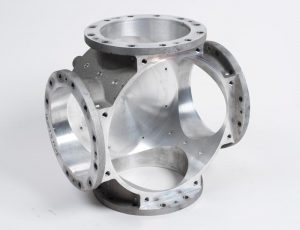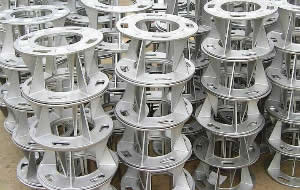Aluminum Casting Techniques: a Deep Study Materials and Techniques for Success
Aluminum casting techniques play a vital role in production. Numerous approaches exist, each fit to various applications and requirements. Sand casting is favored for bigger components, while die casting is understood for its precision in high-volume manufacturing. Financial investment casting supplies comprehensive styles with remarkable finishes. Comprehending these distinctions can substantially impact task outcomes. Aluminum Casting Company. Selecting the appropriate approach is not always straightforward, leading to important considerations that must be explored further.
Comprehending Aluminum Casting: A Review
Aluminum casting is an important manufacturing procedure utilized throughout different sectors to create intricate parts with high precision. This method involves pouring liquified aluminum into a mold and mildew, allowing it to take the form and solidify of the wanted component. The adaptability of aluminum, integrated with its corrosion-resistant and light-weight properties, makes it an ideal choice for applications in automotive, aerospace, and durable goods.
Numerous casting strategies exist, each fit to certain demands and project scales. Aspects such as mold and mildew products, cooling rates, and the intricacy of the style play a considerable function in figuring out the most reliable approach. Furthermore, the homes of the aluminum alloy used can affect the last product's strength, surface, and sturdiness coating.
Recognizing the basics of aluminum casting makes it possible for manufacturers to optimize production processes, reduce waste, and assurance top notch result, which is essential in today's competitive market.
Sand Casting: Applications and strategies
Among the various techniques utilized in aluminum casting, sand casting stands out due to its adaptability and cost-effectiveness. This method involves developing a mold from a mixture of sand and binder, which can be shaped to suit intricate designs. When the mold and mildew is prepared, liquified aluminum is put right into it, permitting detailed attributes and information to be caught.
Sand casting is especially beneficial for creating big components and low-volume manufacturing runs, making it optimal for automobile components, machinery parts, and creative sculptures. The strategy additionally accommodates an array of aluminum alloys, enhancing its adaptability in numerous applications. In addition, the usage of sand as a mold product allows for very easy improvement and reuse, contributing to environmentally lasting methods. However, accomplishing high dimensional accuracy can offer difficulties, necessitating competent craftsmanship and mindful control of the casting process. Overall, sand casting continues to be a basic technique in aluminum foundries worldwide.
Die Casting: Precision and Performance
Die casting is an extremely reliable technique of creating aluminum elements with outstanding dimensional precision and surface area finish. This process involves compeling molten aluminum into a specifically machined mold under high pressure, which enables intricate styles and marginal product waste. The fast air conditioning of the alloy within the mold and mildew results in a strengthened component that frequently calls for little to no additional machining.
Die casting is specifically useful for high-volume production runs, where uniformity and speed are extremely important. It sustains the creation of complex geometries, making it ideal for various applications, including auto, aerospace, and durable goods.
The process can fit different aluminum alloys, boosting the mechanical residential or commercial properties of the completed products. With its capacity to create light-weight yet resilient parts, die casting sticks out as a preferred strategy in modern production, delivering both precision and effectiveness in aluminum casting.
Investment Casting: Information and Complexity
Financial investment casting, also called lost-wax casting, is a functional and accurate approach for generating intricate aluminum parts. This strategy is especially valued for its capability to produce elaborate geometries and great information that are typically unattainable via other casting methods. The process starts with a wax pattern, which is coated in a ceramic shell. When the covering sets, the wax is dissolved, leaving a comprehensive mold for why not look here aluminum putting.
The advantages of financial investment casting include exceptional surface area coating and dimensional accuracy, minimizing the need for extensive machining later. It is particularly beneficial for small to medium production runs where precision is vital. This method suits numerous aluminum Go Here alloys, improving its applicability throughout sectors. Precision aluminum casting. Inevitably, investment casting stands out for its ability to provide both aesthetic allure and practical performance in aluminum elements, making it a preferred selection for developers and designers looking for facility remedies

Picking the Right Technique for Your Task
Just how can one figure out one of the most suitable aluminum casting method for a specific task? The choice procedure depends upon a number of essential factors, including the complexity of the design, the preferred surface coating, and production quantity requirements. For detailed layouts, investment casting often verifies advantageous as a result of its ability to catch great information. Conversely, sand casting may be liked for bigger, less complicated components, using cost-efficiency and versatility in manufacturing.
Considerations relating to tolerances and mechanical buildings of the last product are essential. For high-performance components, die casting may be the most effective choice, as it gives remarkable dimensional precision and surface top quality. In enhancement, comprehending the material residential or commercial properties and compatibility with the picked approach is crucial for making certain the success of the job. Ultimately, a detailed examination of these variables will certainly assist the decision-making procedure, resulting in the most reliable aluminum casting technique for the particular project at hand.
Frequently Asked Inquiries
What Is the Ecological Effect of Aluminum Casting Methods?

How Can I Boost the Surface Complete of Cast Aluminum?
To enhance the surface coating of cast aluminum, one can make use of methods such as sandblasting, brightening, and applying finishings. Proper mold and mildew layout and temperature control likewise substantially enhance the last surface area high quality of the actors item.
What Safety Safety Measures Should Be Taken During Aluminum Casting?
During aluminum casting, essential safety and security preventative measures consist of putting on protective check my blog gear, guaranteeing correct air flow, using fire-resistant products, maintaining a safe distance from molten metal, and adhering to tools safety procedures to prevent crashes and injuries.
Exactly how Do I Repair Common Casting Problems?
To fix typical casting flaws, one need to evaluate the mold for damages, analyze the alloy composition, check pouring temperature, adjust cooling prices, and guarantee proper airing vent to minimize air entrapment and improve casting quality.
What Are the Prices Related To Different Aluminum Casting Techniques?
The costs associated with different aluminum casting strategies differ significantly, influenced by factors such as product costs, equipment, labor, and manufacturing scale. Budget plan considerations are necessary for choosing the most ideal casting approach for particular jobs.
Sand casting is favored for bigger elements, while die casting is known for its precision in high-volume manufacturing. Among the various techniques made use of in aluminum casting, sand casting stands out due to its versatility and cost-effectiveness. Die casting is a very effective method of creating aluminum components with remarkable dimensional accuracy and surface area coating. Investment casting, additionally understood as lost-wax casting, is a accurate and versatile technique for producing complicated aluminum parts. How can one establish the most appropriate aluminum casting technique for a certain task?